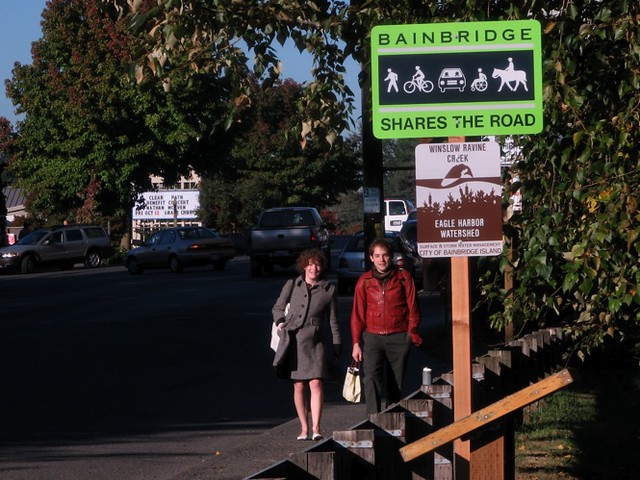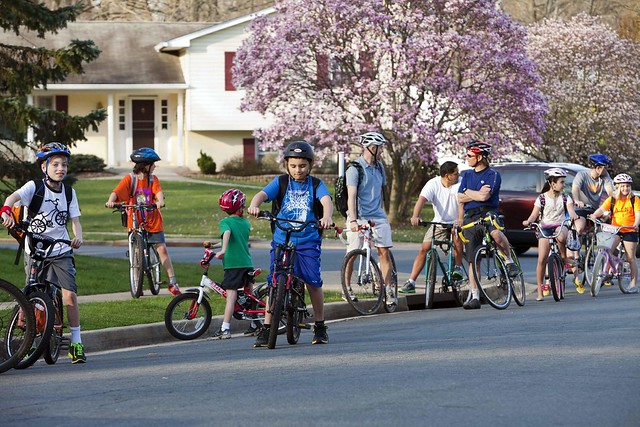DC and Vision Zero Revisited
The Washington Post reports ("New push to reduce traffic deaths in District is part of national effort") that DC is jumping on the traffic safety bandwagon under the rubric of "Vision Zero" initiatives.
When this came up last fall sparked by a GGW entry, I wrote a response, "A "Vision Zero" agenda for DC" which laid out what I thought of as a pretty comprehensive agenda.
In the interim I did come across the city's Highway Safety Performance Plan, which isn't fed into the DDOT Dashboard on traffic deaths, although I did notice in DDOT's post MoveDC Two-Year Action Plan that they intend to improve the Dashboard and to eliminate 25 blocks worth of gaps in the sidewalk network.
And recently I noticed posted at the intersection of Woodley and 34th Streets NW "Neighborhood Slow Zone" street signs similar to but slightly different from the NYC signs (pictured at left).
New points added are identified with an asterisk. The original blog entry includes additional information and links. Additional information is only provided for new items in the list.
*1. Engage citizens in the Vision Zero process from the outset. Focus on capacity building.
-- the University of Minnesota Toward Zero Deaths program annual conference and regional workshops are models for capacity building that could be somewhat repositioned to serve both professional and citizen audiences (like the annual Park Pride conference in Atlanta)
*2. Adopt the "Safe Routes to School" protocol as a planning process and approach for improving neighborhoods more generally, beyond a strict focus on school children. (The Pedestrian Safety Road Audit is a similar tool.)
-- School Walk and Bike Routes: A Guide for Planning and Improving Walk and Bike to School Options for Students, February 2015 edition, Washington State Department of Transportation
-- Pedestrian Road Safety Audit Guidelines and Prompt Lists, Federal Highway Safety Administration.
-- Age Friendly DC planning process.
*3. Create Ward-specific traffic safety committees (walking, biking, neighborhood) that would function as ward-specific subcommittees of the city's standing Pedestrian and Bicycle Advisory Committees, to develop and focus on a ward-wide improvement agenda.
-- Starkville in Motion (Mississippi), Feet First (Seattle), and WalkBoston are great examples of local advocacy groups that do great work on sustainable mobility more broadly rather than biking specifically and would be a model for the kind of organization that DC needs.
 Share the Road sign on Bainbridge Island, Washington state.
Share the Road sign on Bainbridge Island, Washington state.4. Put signage up at the major entry points into the city, stating that the prevailing speed limit is 25 mph, unless posted otherwise. (Re-ordered. This item was originally #1.)
* Garrett Park, Maryland has signage along these lines on Strathmore Avenue, but I don't have a photograph.
5. Develop and deliver a curriculum for traffic safety (bike, walk, transit, drive) for K-12 schools: elementary; junior high; and senior high schools.
*Work with colleges, recreation centers, senior organizations, etc., to provide programming as needed for adult populations. (Re-ordered: this item was #13 in the original list.)
 Photo: Shamus Ian Fatzinger/Fairfax County Times, "Vienna parent’s bike-to-school message spreads."
Photo: Shamus Ian Fatzinger/Fairfax County Times, "Vienna parent’s bike-to-school message spreads." Students and parents gather Wednesday morning in the Oakton Glen neighborhood to bike for a group ride to Flint Hill Elementary School as part of “Walk and Wheels Wednesday.” The program is one of several area spin-offs to Wolftrap Elementary’s “Bike Train,” a monthly ride created in 2009 by parent Jeff Anderson. Parents say Anderson is the driving force behind expanding programs Vienna-wide.

*6. Develop and deliver ward/neighborhood walk and bike events on a seasonal basis in association with the Department of Parks and Recreation, Department of Transportation, and other DC agencies and civic groups.
*7. And regular city wide "Open Streets" events like the CicLAvia in Los Angeles, which is probably the nation's most successful (and is modeled after the Ciclovia program in Bogota, Colombia). CicLAvia regular gets 100,000+ participants at their seasonally-scheduled events.
-- CicLAvia
-- Open Streets Program
-- Open Streets Guide
*8. Ensure that "Safe Routes" neighborhood planning protocols address night-time safety and lighting issues.
-- "Night-time safety: rethinking lighting in the context of a walking community"
9. Make residential street speed limits 20 mph.
10. Change the roadway materials (from asphalt to Belgian Block, etc.) for the streets around pedestrian predominated places e.g., commercial districts, parks, squares and circles, libraries, and Metrorail stations.
11. Change the speed limit around Metrorail stations to 25 mph (or 20 mph).
12. Change winter snow clearance practices to support walking, biking, and transit use.
* -- "Winter Bike Lane Maintenance," white paper, Alta Planning and Design
* -- Chapter 8, Maintenance, Minneapolis Bicycle Facility Design Guidelines
* -- Rochester, New York will clear sidewalks when the snowfall is greater than 4 inches.
13. When possible, separate through traffic from arterials that are also neighborhood serving.
*14. Support the (re)development of dedicated transitways for surface bus service.
-- "We Had Bus Lanes a Half Century Ago and We Can Again," PlanIT Metro blog (WMATA)
15. Collect, maintain and present detailed data on all traffic accidents of all types and put it in real-time on the DDOT Dashboard.
16. Analyze all traffic accidents and incorporate the PEDSAFE and BIKESAFE Safety Guide and Countermeasure Selection Systems and other traffic safety analysis protocols to shape physical and programmatic changes as necessary, when structural-design problems have been elucidated.
*Note that most traditional road safety traffic safety protocols for automobile tend to be standard practice in the Walking City (L'Enfant) urban design that typifies Washington, DC
*Roundabouts are designed to improve automobile throughput, not to improve pedestrian and cyclist safety.
17. Change the legal framework with regard to motor vehicle operation to require that automobiles--as the heaviest and most powerful mobility device--should be accorded the greatest amount of legal responsibility with regard to traffic accidents. (Reordered, slight edits.)
18. Up the penalties for
*19. Develop a Vision Zero related set of questions that must be taken as part of the drivers license renewal process. Generally, after a person receives a drivers license, they are not re-tested. Re-tests could be given at license renewal in order to reinforce public policy goals concerning traffic safety.
DC crosswalk. Photo: H. Darr Beiser, USA Today.
20. Retrain police officers with regard to bike and pedestrian accident analysis *so that their default position is not "the pedestrian/the bicyclist is automatically at fault." (Reordered.)
21. Legalize the Idaho Stop for bicycling.
*22. Consider the development of a bicycle operators endorsement for drivers licenses.
23. Bring back the traffic enforcement division of the police department as a special unit. (Note that the Motor Carrier Safety Unit still exists, although it's probably a federal requirement.)
24. Give parking enforcement officers the training and legal authority to ticket driving infractions.
25. Require specialized training for heavy vehicle operators (e.g., concrete trucks, dump trucks, etc.) with regard to driving in urban conditions, and with pedestrian and bicycle traffic.
Sharper Image bike-mounted rear turn signal.
*26. Advocate to the Consumer Product Safety Commission for the inclusion as original equipment front and back lighting, and left and right turn signals on bicycles intended for urban transportation use
Labels: car culture and automobility, public safety, public space management, traffic engineering, traffic safety and enforcement, urban design/placemaking







2 Comments:
#20 is most critical- police in DC so often point the finger at the cyclist in any bad situation
well, still not sure how to organize the recommendations. They could be along the 6 Es, and we could change "Evaluation" to Engagement and Planning, The police stuff goes under Enforcement, etc.
Post a Comment
<< Home